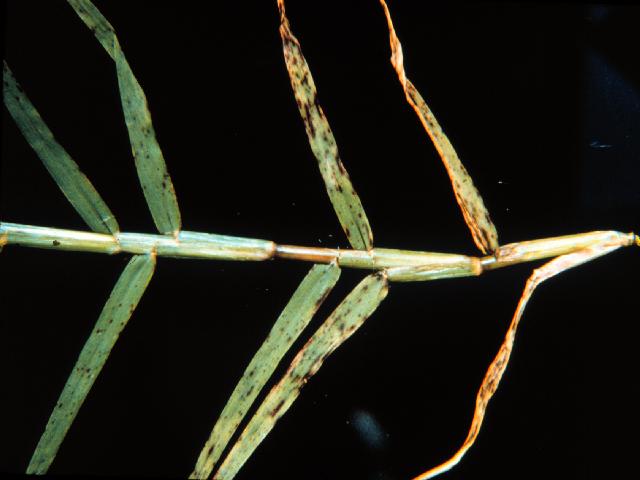
Hay barns like this one in Washington County are starting to fill up again. Fertility management is key to making sure that happens. Photo credit: Mark Mauldin
It’s mid-summer, rain fall has been adequate, and hay barns are starting to fill up across the Panhandle. Recently, I had the opportunity to visit several Bermudagrass hayfields that were not producing up to their potential for both yield and quality. A common trend in these under-performing fields is insufficient fertility management. While many factors can reduce the yield of a hayfield like pests, disease, and drought, they are largely beyond the producer’s control. Often these factors are identified and managed only after yield losses have already occurred. Fertility issues, on the other hand, are different; they can be identified and corrected before yield loss occurs.
Bermudagrass production, quality and quantity, are directly related to the amount of nutrients available in the soil. Nitrogen (N) and Potassium (K) are generally the most limiting nutrients for Bermudagrass production in Florida. Nitrogen levels relate directly to forage yield and protein quality. As nitrogen fertilization rates increase, forage yield and protein levels increase. For this reason some producers think of Bermudagrass fertility only in terms of N, but Potassium (K) is also extremely important, K levels relate to Bermudagrass cold hardiness, stand persistence, and disease resistance. Stand decline and failure are likely if adequate amounts of K are not maintained.

Nitrogen rates directly affect the quality and quantity of bermudagrass hay produced.
Chart from Bermudagrass Production in Florida SS-AGR-60
Properly maintaining soil fertility will not only improve the quality and quantity of the hay produced, it will also help prevent potential problems. Weed control is an ongoing battle in every hay field, and one of the most effective weed control strategies is to have a thick, rapidly growing stand of Bermudagrass. Proper soil fertility can actually reduce the cost of chemical weed control. If weeds are controlled, but poor soil fertility prevents Bermudagrass from quickly filling in the open spaces, new weeds will emerge creating an ongoing need for chemical control. Adequate fertilization also helps Bermudagrass resist disease pressure, especially Helminthosporium leaf spot, and recover rapidly from insect damage.

Helminthosporium is commonly associated with Potassium deficiency.
Photo Credit: Helminthosporium Leaf Spot SS-PLP-9
Hay production removes a tremendous amount of nutrients from the soil. In a grazing situation, some of the nutrients consumed by the livestock are returned to the soil as manure and urine. In a row crop situation some of the nutrients are returned to the soil through that portion of the crop which is left behind (stalks, leaves, roots, etc). Hay production is different, little of the nutrients in the harvested material have an opportunity to be returned to the soil. Considering this, it is imperative that soil fertility be maintained in hay fields.
The University of Florida’s fertilizer recommendations for Bermudagrass hay production are relatively simple. They help producers maintain soil fertility by balancing the amount of fertilizer applied with amount of nutrients removed by each cutting of hay. The recommendations below are expressed in pounds per acre.
- In early spring apply 80lbs N and soil test recommended amounts of P & K
- After each cutting apply 80lbs N and 40lbs K
- If soil test was medium, low or very low, apply 20lbs P after each cutting
- Do not fertilize after last cutting in the fall
In order to maximize the efficiency of the fertilizer applied, proper soil pH should be maintained. In north Florida, this generally means applying lime. The amount of lime needed can be determined through a soil analysis. Have soil analyzed and apply any recommended lime soon after the last cutting is removed. If fertilization is limited due to financial constraints consider the following; 1) Lime is relatively inexpensive, fix the pH first to maximize the availability of any fertilizer applied. 2) Don’t try to save money by skipping the K. Use a lower rate if you need to, but remember to maintain the correct ratio of N and K. (example= 50# N and 25# K/acre after each cutting)
There is no doubt that fertilizer is expensive; but it is important for producers to consider all of the costs associated with not properly maintaining soil nutrients: reduced production, reduced quality, stand decline, increased weed pressure, and increased susceptibility to disease. When viewed in this light, the long-term cost of under-fertilization is much higher than the cost of fertilizer.
- Peanut Maturity Update – 10/9/25 - October 10, 2025
- Fall Can be a Great Time for Vegetation Management - October 3, 2025
- Peanut Maturity Update – 9/25/25 Edition - September 26, 2025
